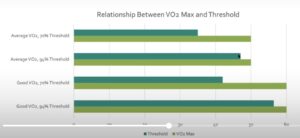Periodization is key to “Aerobic Power” in your final push across that channel.
So much can change when you set out to paddling/racing 32 miles across an open ocean channel – currents, swell, wind, heat or tides, but it’s still 32 miles. So, plan for the worst and hope for the best.
Planning for the worst doesn’t sound that exciting, but it does give your periodized training plan a lot more variety, which helps with your motivation during those months leading into your goal race. What is the take away of this in reference to improving our endurance paddling fitness?
PROS: Periodization; Aerobic Power; Motivation
CONS: currents, tides; wind; swell
When paddling an open ocean endurance race, what you can’t’ control are the currents, tides, wind etc. but what you can control is the correct periodized training to build Aerobic Power and motivation to not completely fatigue against these elements of the open ocean.
Anyone who has trained long distances eg 32 miles, would have felt that heaviness in their arms, shoulders and just about every muscle in their body, at some stage into the distance. It might be only I hour or 4 hours into the distance, but there will be some sign of muscular endurance fatigue. Muscular endurance fatigue after 1 hour is due to very poor preparation and fatigue after 4 hours is due to poor periodization.
So, what is the best periodization for 2 – 8 hour endurance paddling? Simply put, you put down a base and then you build on that base. The bigger the base, the more you can build. Without the base, you may not build enough fatigue resistant muscular endurance, to train 2,3 or 7 hour distances.
In the Base Period, you are preparing to train, not training to race. That’s a big trap a lot of trainers fall into, they get 4 weeks training down and then enter every race they can find. Or, with no races on the COVID calendar, they don’t build a base until the calendar changes, leaving themselves unprepared and fatigued.
Once you have the base down, it’s time to build on it. The Build Phase starts 12 weeks before your goal race and the training becomes more like the race you are training for, with intervals the same as the stresses of the event and building distance that match the event.
Here is my simple break down of a Periodized Training Plan for a paddling season;
Base Phase (6-8 weeks) – General Preparation (Aerobic Threshold)
- Specific Preparation (Aerobic Power)
Build Phase (12 weeks) – Pre-competition (Lactate Threshold)
- Competition (Aerobic Power/Lactate Threshold)
Peak/Taper Phase (2 weeks) – Race Preparation (Lactate Threshold/Aerobic Threshold)
A ‘Needs Analysis” of endurance paddling in the open ocean of distances between 2-8 hours, would require high levels of Aerobic fitness. The three physiological ways to improve that fitness, is by training the Aerobic Capacity, Aerobic Power and Lactate Threshold.
Through experience and from other trainer’s feedback, we know many trainers fatigue to a point that they are no longer racing, but just struggling to complete the distance. So how do we know which Aerobic fitness physiological energy system is lacking? You do a base fitness analysis by asking yourself a few questions.
What are your strengths?
What are your weaknesses?
What is your paddling history?
Eg. How many long trainings/races have you done?
Do you start fast and finish slow, or start slow and finish fast?
Have you always trained long slow miles? Have you done a lot of interval training?
All this will set you up for the correct Periodization training plan. Putting it simply, the faster you can train, for the longest time, the better your result will be. To train faster for longer, you need the highest Lactate Threshold fitness you can achieve, that is your Functional Threshold Pace (FTP), the training zone 3 pace we use at Just Paddling. It’s been proven through scientific testing that the higher you can get your Aerobic Power/VO2 Max, the higher your lactate threshold will become. The average trainer would have a Lactate Threshold of 70% of their Aerobic Power, but you can train your Lactate Threshold to improve up to 94% of Aerobic Power/VO2 Max. So, by improving one or both of these areas – benefits will be achieved.
Working towards improving both your Aerobic Power/VO2 Max and your Lactate Threshold together, will give you the biggest gains in Lactate Threshold speed.

Do a ‘Paddle Needs’ analysis of your paddling experience and Periodize your new training plan with Just Paddling for your next paddling season.

